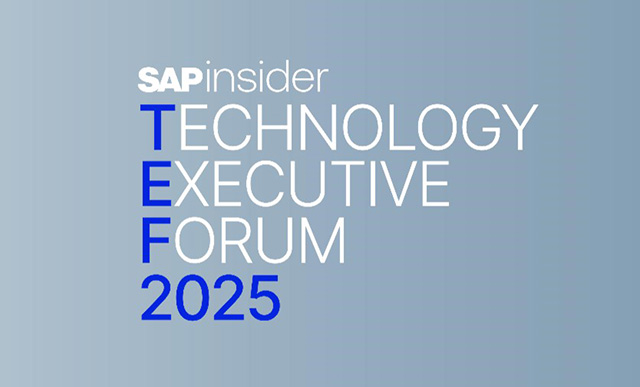Like many SAP customers, Panasonic North America has worked to integrate existing on-premise systems with newly deployed solutions like SAP S/4HANA. Matthew Simoncini, an expert with over 25 years of experience architecting, implementing, and managing SAP solutions, shared his insights on how to manage this connectivity with the SAPinsider community at the 2025 SAPinsider Las Vegas conference.
Panasonic North America, the manufacturing arm of Panasonic in the United States and Canada, initially deployed SAP S/4HANA in 2023 for corporate finance and shared services. While Simoncini wasn’t with Panasonic when the initial deployment was completed, he helped drive the upgrade from SAP S/4HANA 2020 to SAP S/4HANA 2022 which took place in 2024.
Panasonic adopted the clean core mindset from the beginning of their process and use SAP Business Technology Platform (BTP) for extensibility. This made it easier for them to not only bring together the four or five different SAP ECC instances, used by the different Panasonic operating companies, into a single SAP S/4HANA system, it also streamlined their upgrade process. This made it possible for them to complete the production migration on a weekend with only six or seven hours of downtime.
However, the steps become more complicated when managing their ordering process because each of the regional sales entities needed to be able to place orders with the central factory system. While these orders were being processed in SAP S/4HANA, that order needed to be entered into their homegrown, custom-built application that runs Panasonic’s global factories. This involves the order going from SAP S/4HANA to SAP BTP and then to the factory system because it was important to Panasonic that they not build customizations directly in SAP S/4HANA.
The process involves multiple services including Event Mesh, SAP HANA Cloud, cloud foundry, node.js, and the application itself is exposed to the business using SAP Fiori. This is because any interaction that users have with the application needs to feel like SAP S/4HANA. The challenge that Panasonic faced was in monitoring and managing the process. When something goes wrong, how can that be isolated and corrected? Because this is such a critical process, Panasonic needed to remove any unknowns from the management side.
Leveraging SAP Cloud ALM
Panasonic initially looked at SAP Solution Manager to address the problem but quickly determined that it would not meet their needs. In addition, the end of life in 2027 made using Solution Manager less desirable. They then explored SAP Cloud Application Lifecycle Management (ALM). As a RISE with SAP customer, SAP Cloud ALM came as part of the RISE with SAP subscription which meant that no additional investment was required.
However, Panasonic felt that, with a live application, they needed assistance in the configuration so they leveraged SAP MaxAttention services for configuration and implementation. The Cloud ALM deployment collects and stores data, providing traceability and alerting capabilities. In addition, there is an integration with Okta for identity and access management which simplifies user assignment. While there were initial concerns about overwhelming users with alerts, this is something that has been able to be refined over time.
Initial alerts were based on a dashboard, but over time some aspects were changed to email alerts which allowed more proactive alerts when something wasn’t working properly. Panasonic is eventually going to move to integrate the system with ServiceNow where SAP Cloud ALM can create incidents that are automatically assigned to the correct assignment group. Once this is implemented, it will be the completion of the crawl, walk, run methodology that has been taken that has allowed Panasonic to gradually integrate Cloud ALM into their processes.
Over time, Panasonic intends to expand their Cloud ALM deployment beyond the initial operationally focused use case. This will include leveraging Cloud ALM for implementation as well as test automation. Since Cloud ALM is a software-as-a-service solution that is constantly evolving, SAP is constantly adding capabilities that Panasonic is evaluating for future use.
Although Panasonic has had a relatively smooth implementation and deployment of Cloud ALM, Simoncini emphasized several key takeaways from Panasonic’s experience:
- Involve the proper audience from the beginning to avoid needing to explain to them how the system will work after it is built and secure buy-in much later in the process.
- Work with teams like MaxAttention as they can add significant value not only during the initial deployment, but the relationships established will continue to bring benefits over time.
- Always keep track of product capabilities and enhancements to determine where additional benefits can be found.
- Projects like this are not one and done. They are an evolution. Panasonic started with operations and is moving to implementation
By leveraging Cloud ALM, Panasonic has been able to ensure the stability of their order management process as they have adopted new technologies like SAP S/4HANA Cloud within RISE with SAP while continuing to use proprietary systems like their in-house manufacturing systems.
What This Means for SAPinsiders
- Embrace a clean core strategy and evaluate offerings like SAP BTP for extensibility. One of the goals of Panasonic was to avoid customizations within SAP S/4HANA itself. Not only did this allow them to follow a clean core methodology, this approach also simplified Panasonic’s system consolidation and future upgrades. Leveraging SAP BTP for extensibility ensured flexibility without compromising the core system, making upgrades and integrations much easier to manage while allowing them to put in place capabilities that would support integration with legacy or proprietary systems that would not otherwise have been possible.
- Prioritize monitoring and management and explore options that may not have been considered to achieve these goals. Complex processes like order management that span multiple systems require robust monitoring. Panasonic used SAP Cloud ALM to provide monitoring and alerts for potential issues and plans to gradually enhance this setup with further integrations for streamlined incident management. Utilizing SAP Cloud ALM to provide these capabilities helped reduce downtime and improve issue resolution for Panasonic, a major factor when considering the criticality of the interface between order entry in SAP S/HANA and the home-grown customized factory management systems.
- Adopt a phased, collaborative approach with the right expertise. Panasonic’s “crawl, walk, run” approach to SAP Cloud ALM allowed them to evolve capabilities over time—from the initial operations monitoring to eventual broader use cases like implementation and test automation. Part of this process includes involving the right stakeholders early and working with the right partners, for example SAP MaxAttention, to accelerate success and build long-term support. Not every customer necessarily has the ability to use SAP MaxAttention to achieve their goals, but consultants and implementation partners can fill the same role of providing in depth expertise while educating and building ongoing relationships with internal teams.








